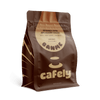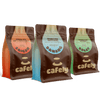Taking that first sip of coffee in the morning is an amazing experience that often feels like rocket fuel. But have you ever wondered how many people share this daily ritual?
Let’s dive into the stats and see just how deep the world’s caffeine addiction runs. We also cover the most popular beans, blends, common brewing methods, and more.
How Many People Drink Coffee?
Coffee is, of course, massively popular. It’s not just coffee nerds like us who can’t get enough — millions of people drink at least a little every single day.
Let’s take a look at some starts in the countries where coffee is most popular:
- 73% of adults in the United States drink coffee daily [1].
- 63% of adults in the United Kingdom drink coffee daily [2].
- Coffee is the most popular per capita in Luxembourg [3].
- 12.6% of the worldwide population (1 billion people) drink coffee [4].
- Coffee is less popular in China, where around 25% of people drink coffee regularly [5].
There are many ways to take your brew, so how do different methods compare?
1. Specialty Coffee

Specialty coffee has seen a huge boom in popularity in recent years, alongside a general desire for clean, tasty, and ethically produced food. A 2020 study found that 49% of Americans drank gourmet coffee beverages over other types [6]. This outranked all the other choices in the survey by at least 12%.
There could be many reasons for this, from the popularity of coffee shops to the desire for ethical and sustainable food and drink. However, one big reason is likely the increased availability of specialty brewers like the Chemex brewer, Hario v60, and phin filter, as well as the range of tasty beans available online.
2. Instant Coffee
Instant coffee is still a popular choice despite the love that specialty coffee has. According to the British Coffee Association (BCA), 80% of people in the UK choose to buy instant coffee to consume at home [7]. Interestingly, a large number of people doing this are 65 or over.
3. Takeout Coffee
Takeout coffee is also popular, with many people visiting their baristas every day. According to the BCA, 80% of people visit coffee shops at least once per week, with 16% of people visiting daily.
However, it’s unclear what kind of coffee shop is most popular. Visiting a chain coffee shop and visiting an independent shop are very different experiences. Either way, the stats show that people are increasingly engaged with their coffee.
How Do People Brew Their Coffee?
As we know, there are many ways to brew coffee, and doing so in different ways can lead to very different final cups.
According to Drive Research, coffee drinkers tend to prefer Keurig coffee pods over other methods [1].
Here’s the data:
- 30% prefer Keurig pods
- 29% prefer drip coffee
- 8% prefer instant coffee
- 8% prefer French press coffee
Drip Coffee Makers
Drip coffee makers are one of the most popular coffee brewers in the US and much of Europe. According to the survey, 29% of coffee drinkers prefer this method.
Drip coffee makers are an easy entry point for specialty coffee since it’s no extra effort to source high-quality grounds and use them instead of the ones you typically buy. Opting for some specialty coffee is great for flavor and freshness.
Specialty Methods
Coffee as a hobby is still quite a niche interest, so data is a little sparse on specialty brewing methods. However, Drive Research’s 2024 survey indicates that 20% of coffee drinkers use “specialty brewers” — not a drip coffee machine or a French press.
This may indicate that potentially 20% of coffee drinkers use specialty methods like pour-over, Aeropress filter, espresso machines, or moka pots. On top of those popular choices, there are also slightly more unusual options like brewing with a phin filter for Vietnamese coffee or a cezve for Turkish coffee. If the 20% represents all of specialty brewing, this is an impressive statistic compared to the 30% of people who prefer Keurig pods or the 29% who opt for drip.
Coffee Pods
Coffee pods are the most popular, with 30% of coffee drinkers responding that it’s their preferred brewing method. The ease of use for an often complex drink is hard to argue with.
This doesn’t necessarily mean that people are avoiding specialty coffee for pods, since you can buy refillable pods to which people often add their own preferred coffee. This combination of ease of use and quality coffee makes them hard to beat.
Where Does Most of the World’s Coffee Come From?
Coffee comes from a wide range of places all over the world. The country that produces the most coffee in the world is Brazil, producing 39% of the world’s coffee due to its sheer size, climate, topography, and soil. This equates to 66.3 million 60-kg bags of coffee between spring 2023 and 2024.
The only other country with a double-digit percentage is Vietnam, with a 16% share. This is followed by Colombia (8%), Ethiopia (5%), and Indonesia (5%).
The Coffee Belt
The main similarity between all of the world's coffee-producing regions is their location on the globe, known as the coffee belt. This is a horizontal strip of the planet between the Tropic of Capricorn at the top and the Tropic of Cancer at the bottom. Most of the world’s coffee is grown in this belt.
Though there are several reasons for this, the main reason is that this region gets an ideal amount of sun and rain for Coffea plants.
Interestingly, the top coffee-consuming countries don’t align with the top coffee-producing countries. All ten of the top coffee-consuming countries are in Europe, with Nordic countries occupying positions two, three, and four on the list.
What Different Coffee Growing Regions Have To Offer
Coffee grown in different regions around the world has different attributes. The term “terroir” refers to a coffee's specific flavor because of its growing location. This term first came from the wine world but has seen popularity in several industries. Here are the terroirs of the main coffee-growing regions.
1. Central and South America
Coffee from Central and South America has a slightly more plant-oriented flavor than other varieties, with the primary standout flavors often being cocoa, nuts, and spices. However, there’s some variation between the two locations. Central American coffees tend to have a lighter body and higher acidity. This makes them ideal as a light roast coffee packed with complex flavors.
2. Africa
Africa is the native home of coffee. The plant grew wild in Ethiopia long before it was cultivated and spread around the world. The beans from this region are particularly adored and are known for having a lighter body and bright flavors. The most common flavor note for African coffees is berries — a combination of gentle acidity and light fruitiness that makes for a delectable brew.
3. Asia
Since Asia is such a vast continent, coffee is grown in many locations. Generally, Asian coffee is split into three main groups — India, Southeast Asia, and Central Asia.
Indian coffee has a spiciness and woodsiness that’s hard to find elsewhere. The spice element is particularly engaging; it tastes spiced like a cake or pie may be, though without the sugar and other ingredients.
Southeast Asian coffee benefits from volcanic soil and high levels of rainfall. Because Vietnam has so many different elevations to grow coffee, the country can produce a wide range of beans.
For example, arabica beans are often grown at high altitudes, offering citrus and fruit notes. Robusta beans grow at a slightly lower altitude, giving them less acidity and an earthy richness.
Why Does Vietnam Grow So Much Coffee?

Vietnam is the second largest coffee-producing country, contributing 16% of the world’s coffee supply. This is a staggering statistic when you consider how physically small Vietnam is compared to other countries.
Brazil’s 39% of global production is 2.4 times the coffee Vietnam produces. Brazil's area is 3.28 million square miles, while Vietnam's is just over 127,881 square miles. That makes Brazil almost twenty-six times larger than Vietnam, despite the smaller country producing nearly half of what Brazil does.
So, with numbers as staggering as this, why does Vietnam produce so much coffee? Well, there’s actually a historical reason. Following the Vietnam War, the government saw coffee as a great commodity crop to improve the country's economy. With reforms that allowed private industries to operate within Vietnam and tax incentives to farm the beans, coffee farming flourished.
This coffee farming tradition has stood the test of time and remains popular and successful today. Vietnam grows a lot of robusta coffee in particular, both due to the local love of this variety and the need for the bean internationally in the form of instant coffee.
How Did Coffee Get So Popular?
Coffee is beloved by a wealth of people, yet it started as some random red berries growing wild in Ethiopia.
So how did this plant make its way around the world and into over a billion coffee cups a day?
Kaldi's Goats
The story goes that a ninth-century goat herder named Kaldi, herding his flock around Ethiopia, noticed his goats eating some particular cherries.
After eating them, the goats seemed stimulated and particularly energetic. Kaldi told the abbot of a local monastery, who used the cherries to make a drink to keep him alert during prayers.
From there, the abbot shared this discovery far and wide.
The Birth of the Cafe
Throughout the fifteenth and sixteenth centuries, coffee spread to social settings like cafes or restaurants. During this time, coffee made its way to areas of modern-day Iran, Egypt, Syria, and Turkey.
It’s said that people deliberately went to these places to drink some coffee and engage in the social nature of the location.
Often, there would be music, news, and other performances, and the stimulating environments became known as “Schools for the Wise.”
Coffee Arrives in Europe
From the Middle East, coffee spread throughout Europe in the 17th century to mixed reception.
Some people loathed the bitter taste, but the stimulating nature of the drink made it exceptionally popular.
Soon, alcohol-oriented social hubs were replaced by cafes, and everyone was drinking coffee. In a sense, the “Schools for the Wise” had been recreated, commonly called “Penny Universities” in England.
From there, the only way was up — many people had sampled the drink and loved it for its flavor and caffeine content and rich history.
Because of this love, the plants were spread worldwide and cultivated to create a booming coffee industry.
The rest, as they say, is history.
FAQs: How Many People Drink Coffee?
Now that we’ve got a great understanding of how many people drink coffee, let's answer some of your most frequently asked questions.
1. What Percentage of Humans Drink Coffee?
It’s estimated that around 12% of the world’s population drinks coffee daily — that’s over one billion people.
2. Is Coffee the Most Consumed Drink in the World?
While the statistics go back and forth between tea or coffee being the most popular in several countries, tea is actually the most popular drink worldwide. As an estimate, about 5 billion cups of tea are consumed daily, compared to 2 billion cups of coffee.
3. What Country Drinks Coffee Most?
Finland is the world's number one coffee-drinking country, with an average consumption of around 26 lbs per year per capita.
4. What Age Group Drinks the Most Coffee?
People sixty or older tend to drink the most coffee of all age groups. Approximately 72% of Americans over sixty drink coffee every day.
5. Is Coffee Healthy?
Yes, coffee can be very healthy! Most notably, researchers have found a link between drinking more coffee and decreasing a person’s risk of developing type 2 diabetes [9].
6. What Profession Drinks the Most Coffee?
Scientists or lab technicians drink the most coffee at work. This may be due to their long, erratic schedules and tight deadlines.
7. Do Brits Drink a Lot of Coffee?
Yes, British people have a particular fondness for coffee, even compared to the country's historical love of tea. Around 20% of people drink just one cup of tea per day, compared to around 28% of people who drink just one cup of coffee.
8. Is Coffee More Popular Than Coke?
This is quite hard to say because people consume coffee and Coke in so many different ways. Research shows that soft drink consumption is generally higher than coffee consumption. However, the consumption of soft drinks is falling, and the consumption of coffee is rising.
9. What Percentage of Adults Don’t Drink Coffee?
In response to a survey in 2022, 23% of people said that they don’t drink any coffee at all [8].
10. What Country Has The Best Coffee?
That’s a very tough question to answer since it depends on what you might look for in your cup. However, we would say that Vietnamese coffee is a little better than the competition, thanks to the sheer variety of coffee produced in the country.
References:
- Rodgers, E. (2024, February 1). 2024 coffee statistics: Consumption, preferences, & spending. Full-Service Market Research Company.
- Bellis, J. (2025, January 15). Coffee Consumption Statistics UK 2025 (Researchers handbook). Balance Coffee: Buy Healthy Coffee Roasted In The UK.
- A life of coffee. CAFELY. (n.d.).
- Yaqub, M. (2025, February 21). How many people drink coffee in the world?. CoffeeDasher.
- Ou, X. (2024, November 22). China: Frequency of drinking coffee 2024 | statista. Statista.
- Share of US gourmet coffee beverage consumption by type 2020. (n.d.). Statista. Retrieved February 21, 2024
- Brown, T. (2021, December 27). Coffee consumption. British Coffee Association.
- UK: Coffee consumption frequency 2022. (n.d.). Statista. Retrieved February 19, 2024
- Kolb, H., Martin, S., & Kempf, K. (2021). Coffee and Lower Risk of Type 2 Diabetes: Arguments for a Causal Relationship. Nutrients, 13(4), 1144.










